Heap vs Google Analytics: Which Is Better In 2022?
Google Analytics and Heap are two well-known analytics tools. They help you track, collect, and analyze different metrics about your website, provide insights into your online presence, and create strategies directed at the behavior of your user segments.
Even though these two products look similar, they have some fundamental differences. While Google Analytics focuses on pageviews, Heap mainly tracks event-based data. Another difference is the information they provide about customers: Google Analytics tracks “who” while Heap tracks the “what” of the customer journey.
Before making a decision between these two analytics tools, you need to compare the metrics, features, integrations, etc. they offer and choose accordingly. This article will help you make a better decision by comparing these two tools in detail.
Heap | Google Analytics | |
No-code & Retroactive Tracking | ||
Easy-to-use | ||
Marketing Analytics | ||
Cookieless | ||
Understand what drives revenue for your SaaS | ||
Flows | ||
Capterra Rating | 4.5/5 | 4.7/5 |
Free Trial | Free plan | Free |
Plans with all features prices start at | Undisclosed | Free |
What is Heap?
Heap is a no-code product analytics tool founded in 2013 by Ravi Parikh and Matin Movassate. Heap product analytics aims to create a better and stronger online presence for its customers of all sizes and increase customer engagement. It tracks, collects, and analyzes data about the customer journey and your customers’ characteristics and habits. They started their journey with the motto of “capturing everything” as Heap is a no-code tool that tracks every action.
Rather than only looking at the big picture, Heap focuses on tracking every action taken by your customers. This helps you collect data according to your needs and preferences and see the emerging patterns of your customers.
Another great advantage of Heap is that you don’t need to have coding knowledge to retroactively track data from day one. By automatically collecting data and organizing it into useful reports, Heap helps you strategize data-driven plans and speeds up the decision-making process.
What is Google Analytics?
Google Analytics (GA) is a well-known web analytics platform offered by Google. It tracks and analyzes different marketing metrics (bounce rate, conversion rate, etc.) and provides you with valuable information about your product. So, if you want to track events on your web page with an analytics tool, GA is one of the most popular options on the market.
Google Analytics was released in November 2005, and the basis of the platform leaned on Urchin, a web analytics software that was acquired by Google at the beginning of 2005. Google Analytics started its journey aiming to make web analytics accessible and convenient for its customers. Because it is one of the most comprehensive and free analytics tools on the market, it quickly became a powerful player.
Google Analytics focuses on pageview data, meaning it tracks specific routes and end-points your users are taking throughout their visit to your website. This feature allows you to see various sources of traffic attribution, and specific information about your customers’ habits, and user journeys and helps you to make data-driven decisions for the future.
Google Analytics always aims to provide you with useful information to optimize your online performance. Therefore, it collects and analyzes data in four different categories: the session level, event level, pageview level, and user level. Google Analytics combines these four into one and presents you with holistic reports.
Differences between Heap and Google Analytics
Event Tracking
Google Analytics is a page view-based tool, so it can only track metrics about page views. Though it’s mostly limited to page-based analytics, the features that GA offers are pretty useful. One of these features is form tracking, which tracks the channel and term that led customers to form submissions on your page. Analyzing these touchpoints helps you increase the interactions with your CTAs and may increase your sign-up rate.
Collect and view marketing, sales, and product touchpoints across channels
Click on the dashboard image to see the template!

There are default, pre-set events available, though they are pretty basic and you’ll likely need custom events, which you’ll need to implement yourself. To do this, you’ll need to add snippets of custom-written code to the items that you want to track. If you’re a beginner at using analytics products, this process may be challenging, and you may want to opt-out to a no-code Google Analytics alternative like HockeyStack instead.
Heap, on the other hand, supports retroactive automatic event tracking which is a trait of plenty of analytics and attribution tools including HockeyStack. With Heap, you can track and analyze every type of user event such as clicks, taps, swipes, etc. without having to manually tag a user behavior as you’d have to with GA.
Heap also provides insight into events by showing where people encounter friction in the customer journey. This is different than GA, which only tracks events without getting into detail. You can also perform funnel analysis and create user segments while tracking events. However, some features that GA offers, such as the tracking feature that analyzed form submissions, aren’t available on Heap.
Social Analytics
Google Analytics can measure and analyze your brand’s social media presence in just a few clicks. Because it is a social platform, which offers different integrations to track your social media accounts, you can easily get insights into the exposure your accounts get.
On the other hand, Heap does not focus on social media as much as GA does. This product’s focus is more on product analytics and less on revenue/marketing attribution. So, if you want to see the contribution of Instagram to your MRR, for example, you should look for a Heap alternative.
User Interface
Google Analytics is not the easiest tool to learn: It has a steep learning curve particularly owing to the complicated options. Even though it is not hard to adapt to this tool, it is more complex than Heap and there’s less support available. You also need to set some actions manually and do custom development.
User Tracking
Google Analytics gives an overview of your customer base and its patterns, but it doesn’t show each user’s journey by default. You can set up the User ID reporting feature, which will show you the access patterns, most visited pages, and repeating behavior of individual customers, though you won’t have access to personal data (which makes reaching a specific customer after viewing their customer journey almost impossible.)
However, Heap can display an individual user’s journey as well as an overview of your whole customer base. With Heap, you can see behavioral patterns of user segments or individual users. Heap also offers a feature called “Effort Analysis,” which combines the time spent on page, engagement, and interactions on your product or page to track the amount of effort customers have to put in during their journeys. So, you can both track and optimize user journeys with Heap, unlike GA.
Similarities between Heap and Google Analytics
Features
Both analytics tools offer similar kinds of features. There is an extensive set of features according to the metrics you want to track or data you want to collect. You can also access actionable data, set custom goals, perform funnel analysis, and create reports with both tools. Both enable user journey tracking to some extent.
Since both of the tools are heavy on features, sometimes it is hard to understand and learn the products.
Learning Curve
While the interfaces of both tools are quite different, both tools require a lot of time and effort to learn all the features and tools. This results in a steep learning curve, which is not ideal if you want to use the tool as soon as possible. This learning curve should be a determining factor in your decision-making since this means spending time integrating your this new tool into your business. It’s often better to choose a product analytics tool like HockeyStack that’s easy to set up and has a drag and drop interface so that you don’t spend time switching products.
Reporting
Data visualization is an important part of every reporting tool. Luckily for you, both tools offer a variety of visuals and graphs to support their reports, and the reports they provide are simple and convenient. It is easy to discern useful information about user behavior, which will help you make plans for the future and assess your weaknesses and strengths. Similarly, the graphs on the reports help you to see different statistics easily and compare different metrics.
Pricing
Heap
Heap offers four different pricing plans according to the scale of your business: Free, Growth, Pro, and Premier. While the most basic plan is free, Heap also offers a free trial for Growth and Pro plans. Since each pricing plan is custom-made, you can contact a sales representative to tailor-made a plan just for your own needs.
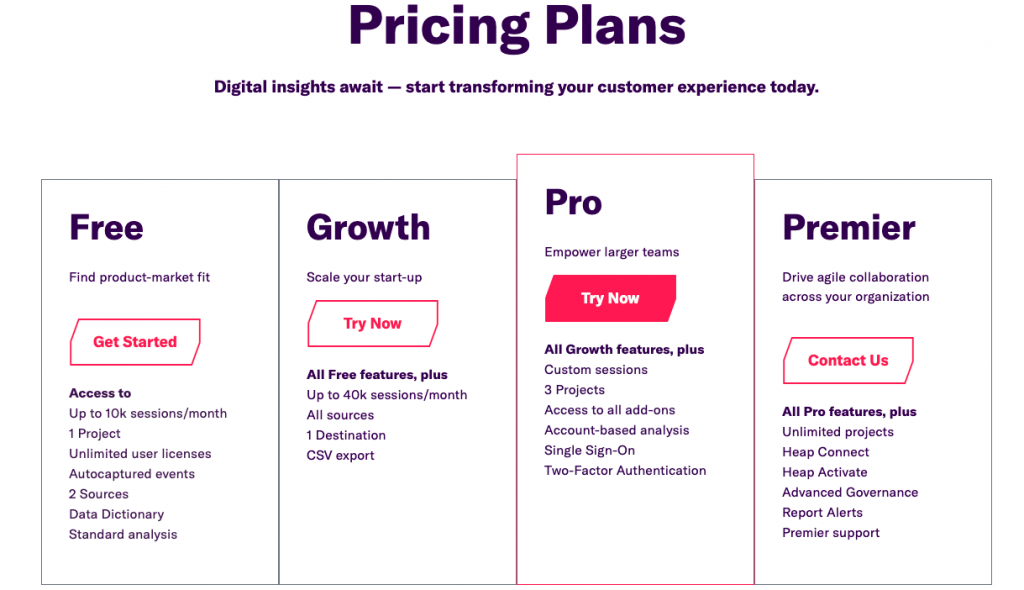
Google Analytics
Google Analytics only offers two price plans: Google Analytics and Google Analytics 360. The paid version, Google Analytics 360, is far more comprehensive than the free plan, and the costs start from $150,000/year, increasing based on the features and capabilities you need. So, if you’re a smaller company that wants to integrate all customer data from multiple touchpoints for a holistic view or you want to see your product, revenue, and marketing data in tandem, you can check out Google Analytics alternatives such as HockeyStack.
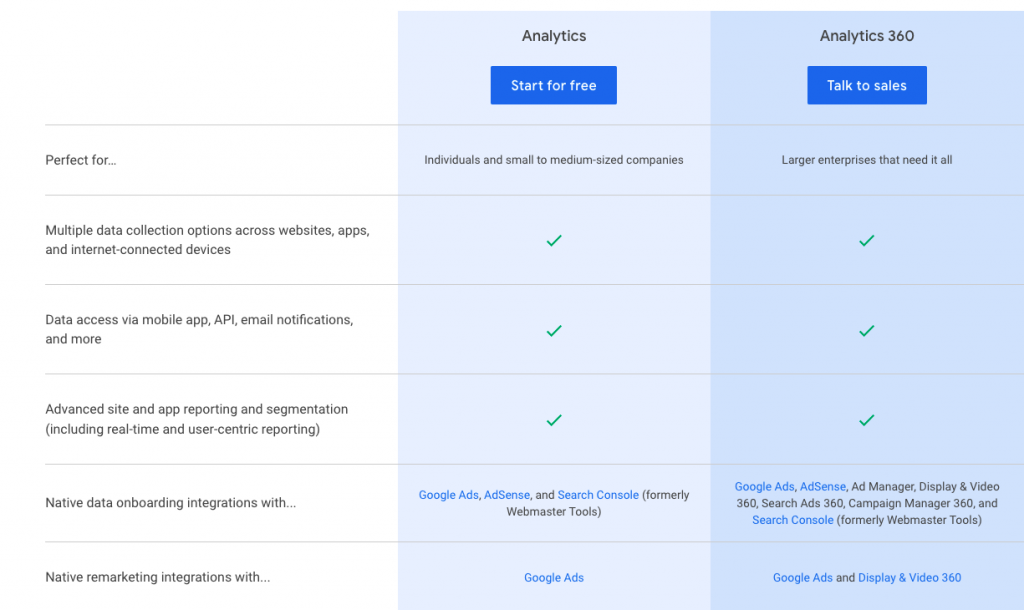
Comparison
Even though both platforms offer a free plan, Google Analytics proves to be a far better choice because of the extent of its capabilities. On the other hand, because Heap offers four different price plans, you can find the best one according to your needs without spending a lot of money. More advanced versions of both Heap and Google Analytics are custom-made, so you cannot access a predicted cost, which is a disadvantage for both of the tools. Because Google Analytics includes more features without a cost, it is widely used in the market.
Integrations
For web analytics tools, it is very important to have an extensive and versatile list of integrations. Integrations allow users to consolidate data from various platforms without expending any additional time or effort. Therefore, when you’re choosing a tool for analytics, it’s essential to take a look at the platforms they support.
Why Not Simplify Your Analytics?
Track key metrics, identify trends, and mitigate risks with greater visibility into your marketing, sales, and product data
Try HockeyStack Today
Heap
Heap provides many different integrations sectioned in different categories: Attribution platform, CRM, Customer Data Platform, Customer Success, Data Warehouses (Heap Connect), Email Marketing, Marketing Automation, Payments, Pipelines, Session Replay, SSO (Single Sign-On), Testing & Personalization, User Guides, and Other.
The most popular integrations:
- Appcues
- Shopify
- Redshift
- S3
- Intercom
- Salesforce
Other notable integrations:
- Zendesk
- Hubspot
- Mailchimp
- Marketo
- Zapier
- Stripe
- Stitch
- FullStory
- Single Sign- On: Google Apps
- Oracle Maxymiser
Google Analytics
One of the huge advantages of Google Analytics over its competitors is that it offers complete integration with almost all of the Google platforms. Other than providing integration with Google-based products, GA also has a comprehensive list of other integrations.
Powerful Google Analytics integrations:
- Salesforce
- CallRail
- DoubleClick Campaign Manager
- Shopify
- Zendesk
- Marketo
- WordPress
- VWO
- Hootsuite
Other notable integrations:
- AddThis
- Eventbrite
- Magento
- Mailchimp
- Segment
- Wix Zoho
- Tableau
- VimeoPro
- ClassDojo
Comparison
Looking at both analytics tools, you can see some similarities as well as some distinctive differences. Even though Heap offers some well-known and useful integrations, the integrations of Google Analytics are much more extensive and versatile. Google Analytics can integrate with many products from different fields, which can help you a lot according to your needs and preferences. If you are going to choose Heap, you need to be careful about whether the integrations you need are available or not.
Reviews
Heap
“If you’re starting a new product, go for it. If you’re switching from an existing analytics tool, definitely sit down and think about how your processes will change as a result.”
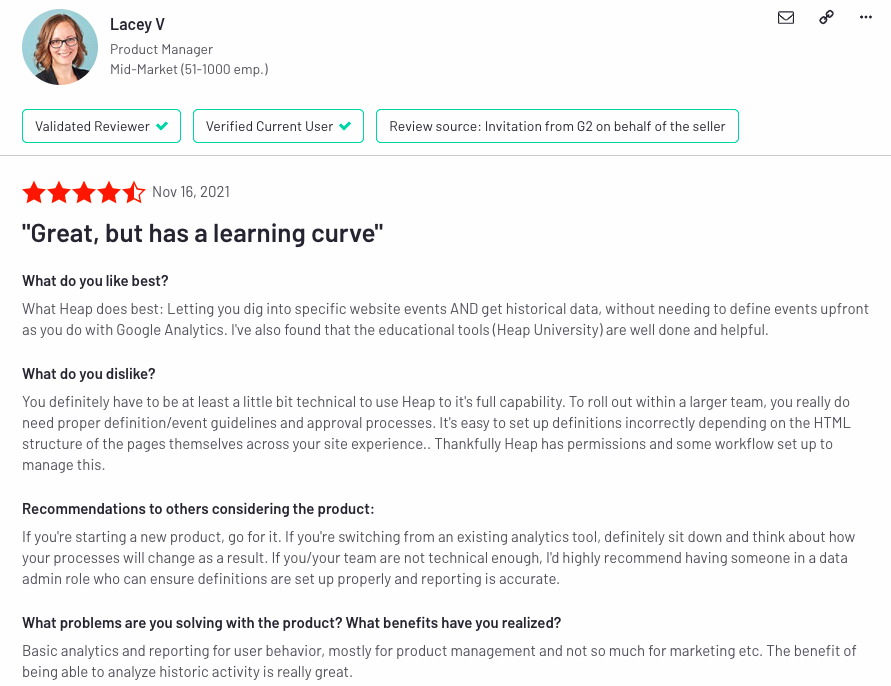
“Customizable overviews of metrics combined with comprehensive reports give our company a detailed overview of user data and usage in as broad or as defined of a scope as we needed according to our project goals.”
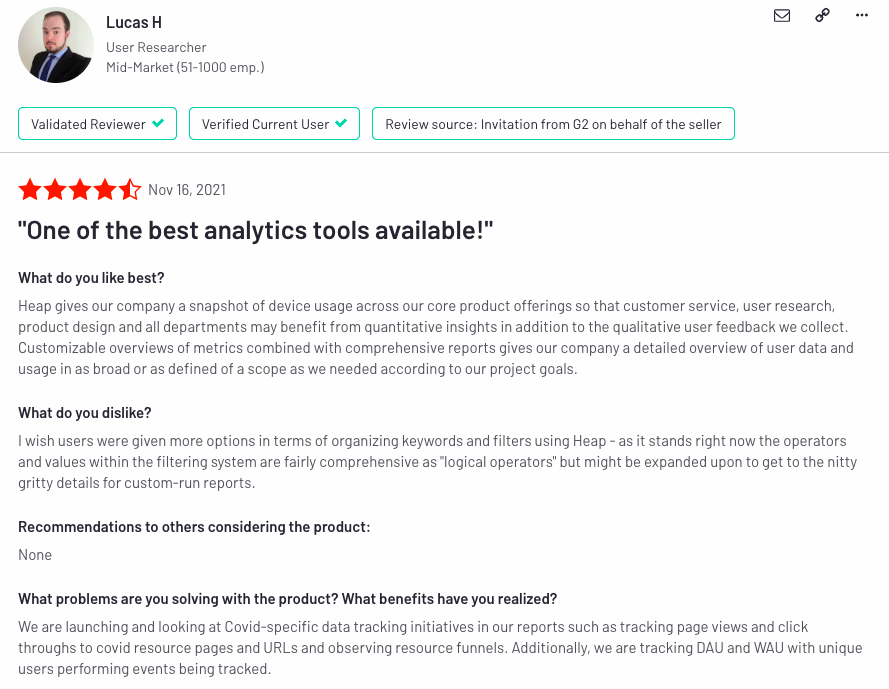
“We were able to use Heap to create retroactive analytics segments to find our target audience.”
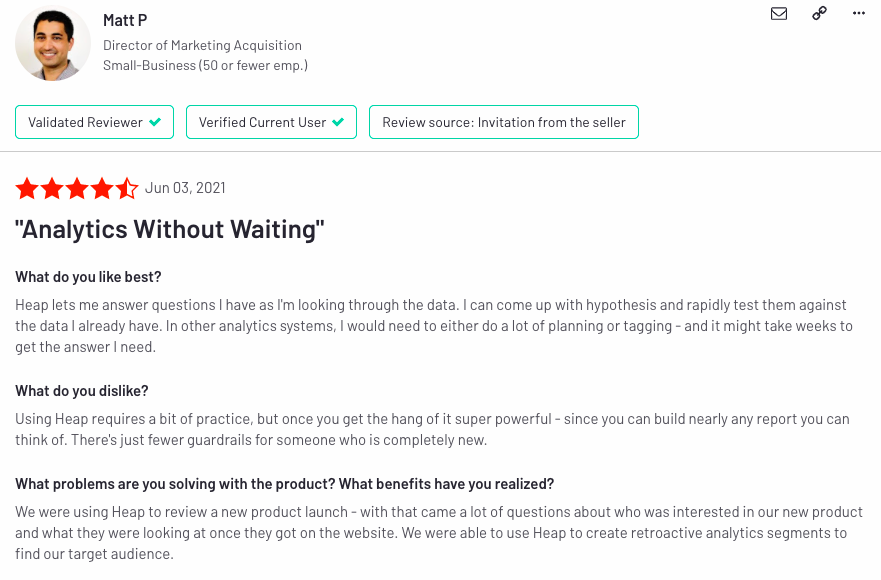
Google Analytics
“You can track everything from gender and location to the keywords being used to find your page. I also love how easy it is to use.”
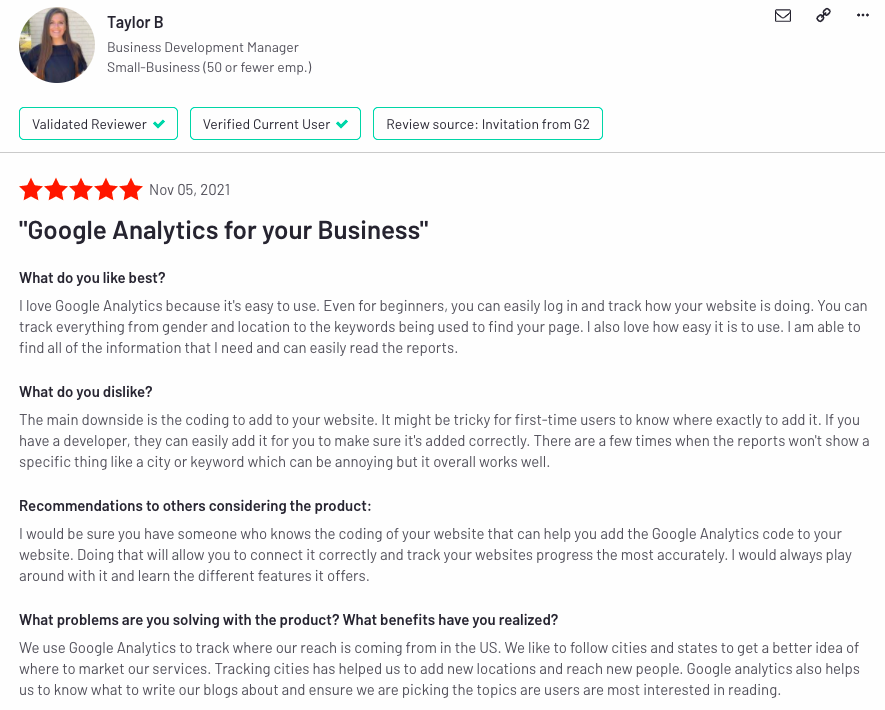
“If you know what you are doing, it’s a great tool. Otherwise, be prepared to learn.”
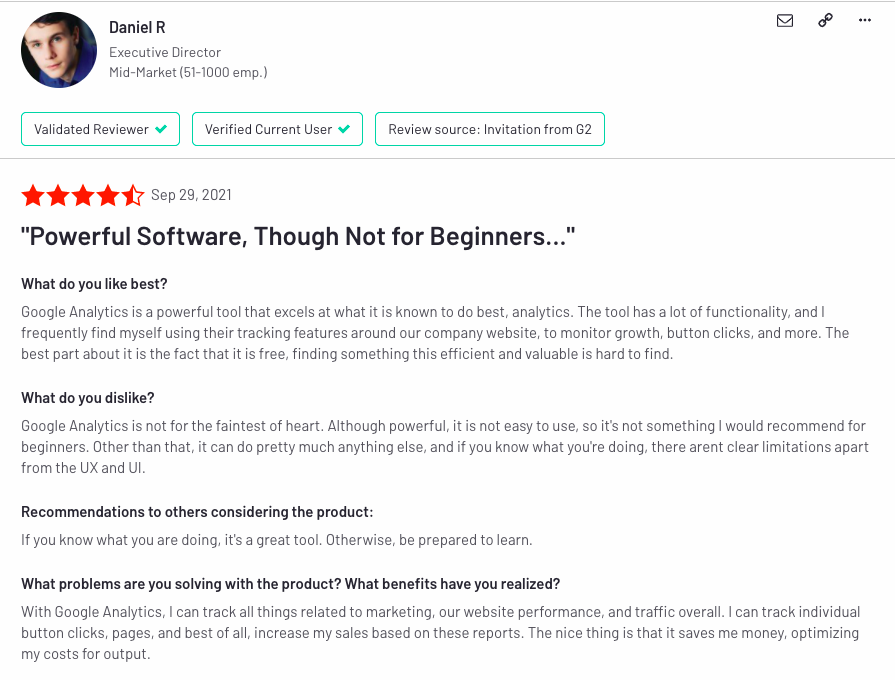
“We embed Google Analytics in clients’ websites before deploying them. It gives them a simple overview of the paid/organic/direct traffic.”
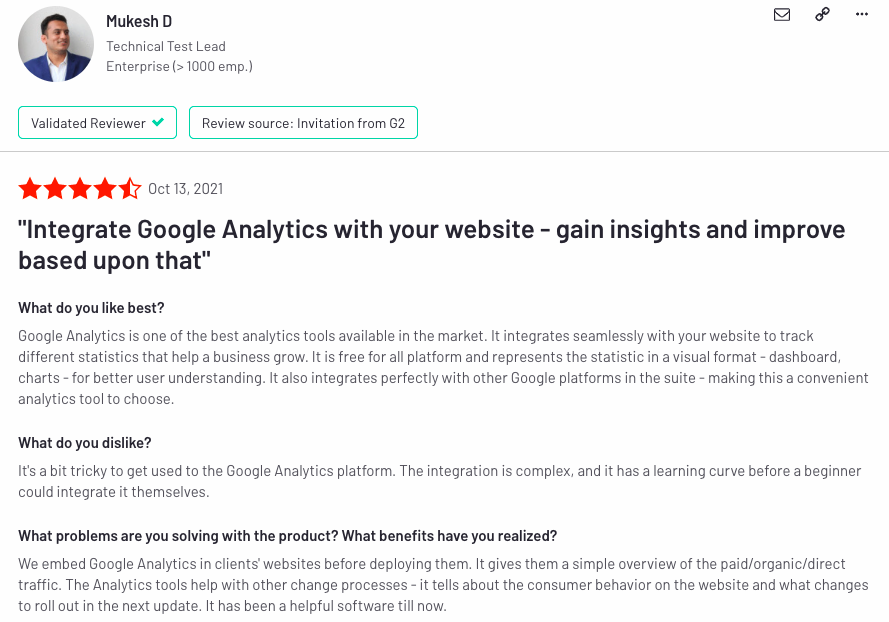
Top Factors to Consider When Settling the Heap vs. Google Analytics Debate
Here are the tops factors that you should consider when deciding between Heap and Google Analytics for your company.
Event Tracking
Before deciding on Heap or Google Analytics, you need to make sure whether your product will get more benefits from a page view-based tool or an event-based tool. If you want to track and collect specific details about your page views, you should consider Google Analytics. However, if you want to dive deeper into the actions your customers are taking, you can benefit from Heap or a similar tool such as Hockeystack which can track each event with great accuracy. At the end of the day, you need to be certain of your needs and understand what you need from your analytics tool.
Pricing
Both analytics tools offer free and paid plans. While Google Analytics has a great variety of features, metrics, and tools in its free version, Heap’s free plan is quite limited. However, if you are a middle-sized company, you may need some extra features. If you choose Google Analytics 360, you may spend money on features you don’t need. Therefore, Heap ‘s pricing is a better alternative in this situation.
Integrations
Google Analytics’ list of integrations gives a huge advantage over its competitors. It can integrate both with Google products and other platforms. On the other hand, even though the integration list of Heap is much shorter than Google Analytics, it has most of the common and useful integrations. Before deciding, you need to make sure that the integrations you need are available on any of the analytics tools.
Product Metrics
If you are working at a SaaS company, then product engagement is integral to your company’s success. Heap is much better at product analytics than Google Analytics is, which helps you increase net dollar retention rate and decrease your churn rate.
Conclusion
Heap and Google Analytics are both good web/product analytics tools to choose from. If you want to track events, Heap can be a better tool. On the other hand, if you want to focus on details about pageviews, Google Analytics is the choice for you. That said, it’s important to look beyond this and go through the features, integrations, and pricing of each before making a decision.
In the end, both tools have similar functionality in terms of collecting and unifying data. However, if you’re looking for a no-code tool that you can use for web analytics, customer engagement, and unifying departmental data, HockeyStack is a great option for you. In addition to creating customized dashboards from a drag-and-drop designer, Hockeystack can help you gain greater insight into customer behavior, allowing you to enhance the customer experience for increased revenue.
Complete with integrations to popular sales and marketing tools and ready-to-use templates, HockeyStack simplifies analytics, allowing business users to take full control of their data for accurate decision-making.

At the end of the day though, it is very important that you are considering your needs and preferences to choose the best web analytics tool because both of these tools have been designed for specific reasons and aim to solve different problems.
FAQ
Yes and no. It offers a free plan, which is the most basic version of Heap. However, if you want to access more features and tools, you need to buy one of three plans: Growth, Pro, and Premier. These plans offer different features according to your business’s scale and your preferences. Each of the plans is tailor-made specifically to your needs; therefore, there is no set price. You need to contact a sales representative for further information.
Heap stores data in its warehouses, which are managed by Heap Connect. You can easily and seamlessly bring user data into warehouses and manage them automatically. In addition, these warehouses collect and store data retroactively, meaning that you have access to any type of data from day one. This helps you to organize your past data and control your future data.





